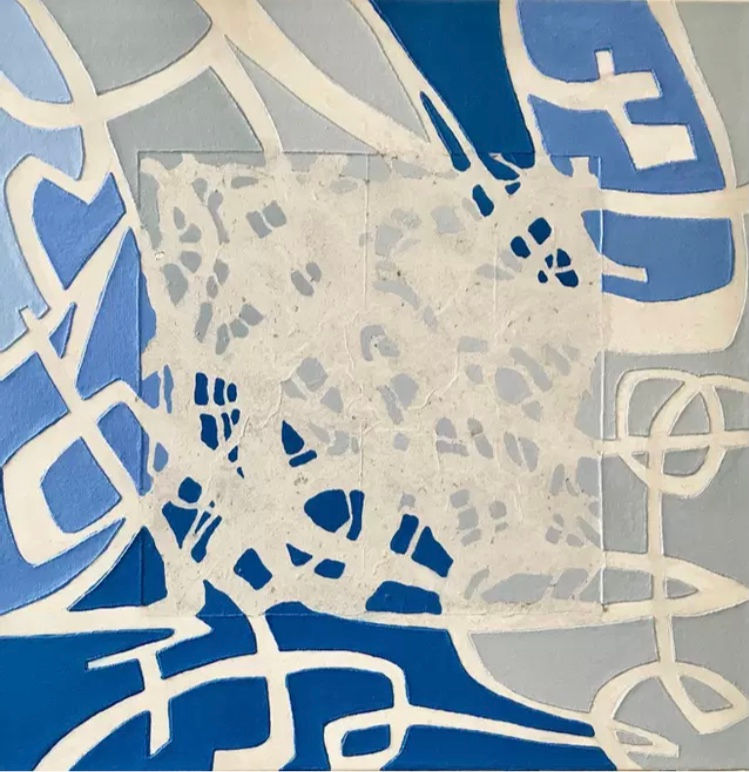Sheridan Russell Gallery
Kitty Jun-Im
Kitty Jun-Im is Korean, but her formal art training has taken place in British art institutions.
A striking quality of her paintings is the rich, tactile surface, composed of rhythmic, linear elements crossing the canvasses in successive layers. In some areas, these are calligraphic; in others, woven meshes of paint; elsewhere, a kind of pictorial choreography. Paint medium is, also, poured so as to tether sheets of Hanji paper, which become transformed into floating, central screens. These same motifs, are, sometimes, built up from juxtaposed webs of paint, alone; in places, thickly visceral, in others, thinly transparent. Everywhere, the sense of touch is intimate and spontaneous, pulsing and alive; suggesting that, for this artist, painting and music making (which she practises, also) have a close correspondence.
Colour in the paintings is equally personal and sensuous, extending in breadth from deeply saturated to barest tint and having the luminosity of Oriental silks and ceramics. Its accompaniment to the linear forms is evocative, rather than descriptive and, here to, analogies with music (the most abstract of arts and the most expressive of pure feeling) come readily to mind. Each painting bears a distinctive colouration, which establishes a mood, or ambience; often, the trigger to the viewer's initial response, like glimpsing an exotic bird, then watching it's flight, listening for it's call.
The paintings seem to contain hints and clues about the artists's life: could the meandering lines relate to retraced journeys, or veins connecting organs within the body: the varied handling of paint, to dense vegetation, or shimmering light: the grids, to nets that trap images of remembered objects: the centred rectangles, to the inner self? Such teasing free-associations may owe something, not only to the artist's inventive practices but, also, to her diverse past. The early years in Korea; leaving home to travel in Europe; life as a musician; settling in an adopted country: all these far-ranging experiences must be a fertile source for ideas and images, if only sub-consciously.
The artist, herself, is reluctant to admit to any specific meanings and the paintings have an elusiveness which makes analysis of this kind counterproductive - a sense of mystery is part of their appeal. Reaching the mind through waves of sensation, they can become mesmeric, when an Eastern stillness emerges, reflective, serene, meditative. But, at the same time, they can seem to exist simply to be enjoyed, purely aesthetically. Here, is an original and abundantly gifted artist, whose work enhances our awareness of living.
Alan Plummer
Formerly Head of Fine Art Department,
University of Reading

Acrylic and mixed media on canvas 76x61cm £1,800

Acrylic on canvas, 20x30.5cm £690

Acrylic on canvas 122x91.5cm £3,000

Acrylic on canvas, 160x160cm £5,900

Acrylic on canvas 61x61cm £1,500

Acrylic on canvas 91.5x61cm £2,100

Acrylic and mixed media 152x122cm £5,100

Acrylic and mixed media 152x152cm £6,100

Acrylic and mixed media 91.5x122cm £3,000

Acrylic and mixed media 107x107cm £3,600

Acrylic on canvas 20x30.5cm £690

Acrylic and Mixed media on Canvas 76x76cm £1,900

Acrylic on canvas 51x51cm £1,200

Acrylic on canvas 20x30.5cm £690

Acrylic and mixed media on Canvas 74x74 £2,100

Acrylic on canvas 51x51cm £1,200

Acrylic and mixed media 122x91.5cm £3,000

Acrylic and mixed media on canvas 107x107cm £3,300